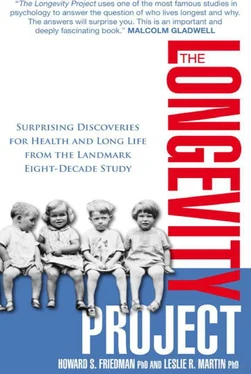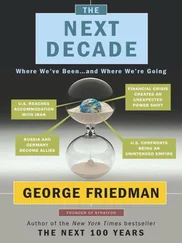That said, exciting new lines of research within psychology have begun to show how people can change—albeit slowly and with substantial effort. As we will see, consistently placing oneself in groups where one will meet new people can help turn a temperamentally shy person into more of a (mild) social butterfly, for instance. And if we decide that we want to cultivate a trait such as dependability, we can analyze our actions, act “as if ” we already possessed those traits, and vigilantly monitor and correct for any slips back to our baseline way of behaving. All of which is to say that if your personality traits don’t match those on the pathways to longevity, you can make an effort to expand those needed aspects. The long-lived Terman participants did.
Personality Detectives on the Case
We dug into Terman’s archives. Thousands of pieces of information had been collected on each participant for decades. So we started by examining all the items that seemed relevant to personality. Near the outset, in 1922, each participant’s parents (usually the mother, or both parents together) and the teacher were asked to rate the child on dozens of trait dimensions. Dr. Terman’s interests were wide-ranging—he attempted to measure the intellectual, volitional, moral, emotional, aesthetic, physical, and social functioning of each child!
For example, using a thirteen-point scale, Patricia’s mother and her sixth-grade teacher rated her according to the degree to which she appeared to be popular, cheerful, and prudent, among many other traits and dimensions. The picture that emerged was one of a girl who was well liked but not a leader or the most popular student in the class. She enjoyed school and had excellent attendance, and her teacher reported that she seemed particularly drawn to atlases and encyclopedias. Despite being rather bookish, Patricia was not overly shy, and she spent time regularly with several close friends who shared her interests in birds and other wildlife, knitting, and movie stars. Still, as we examined her life over the years, we began referring to her as Prudent Patricia.
Terman’s original personality rating scales, now almost a century old, are remarkably modern in their appearance. We could directly analyze them using modern statistics, and so we derived and validated a small number of core personality traits to understand Patricia and her peers. We called one of these “Sociability” and another “Conscientiousness and Social Dependability.”
The Sociability index reflects a tendency to prefer being around others. That is, was the child popular, often a leader, fond of being in large groups, and showing a preference for playing with others and being involved in social activities? Patricia was not particularly popular or social and scored about average on this scale. Terman participant James, on the other hand, was a leader and scored high on this index. James tended to think things out for himself, but he was also quite sensitive to the approval of his peers. Charismatic and exceptionally tactful, James successfully garnered the goodwill of his classmates and had many friends—he was a universal favorite at school.
The Conscientiousness scale combined four other characteristics that parents and teachers had rated: how prudent was the child, how conscientious, how truthful, and how free from vanity and egotism? Some people are clearly more conscientious and dependable than others.
We also measured other core personality traits, such as cheerfulness, moodiness, and more—all of which we’ll delve into in later chapters.
• • •
After doing years of work on a research project, a moment of truth approaches. In our case, we had painstakingly put together and validated measures of childhood personality, and we had searched high and low for death certificates.
We initially expected that four or five particular traits might be especially relevant. It would make sense if the most sociable children went on to live long lives. After all, scientific studies have firmly established that individuals who are well integrated into communities are generally healthier, as compared to the lonely recluses. We also thought that the cheerful, optimistic children would probably live long lives. The airwaves are full of advice to “cheer up” to stay healthy.
Highly conscientious individuals, we hypothesized, might stay healthier and live longer—perhaps those who were careful and diligent would take better care of themselves. Finally, we had some ideas about individuals who were worriers, got excited, were easily provoked to anger and distress, and so on. We predicted less healthy fates for the moody and troubled. But it did not really matter what we expected; the findings would speak for themselves. We’d quickly discover that our hypotheses—steeped in conventional wisdom from shorter-term studies of personality and health—would only sometimes be right.
CHAPTER 2
Long Live the Prudent and Persistent
As our graduate students looked over the initial statistical findings on personality and long life, they gasped and laughed as they read the results: “Howard, that sounds like you!” The findings clearly revealed that the best childhood personality predictor of longevity was conscientiousness—the qualities of a prudent, persistent, well-organized person, like a scientist—professor—somewhat obsessive and not at all carefree.
It was not cheerfulness and it was not having a sociable personality that predicted long life across the ensuing many decades. Certain other factors were also relevant, but the prudent, dependable children lived the longest. The strength of this finding was unexpected, but it proved to be a very important and enduring one.
We had worried that perhaps nothing at all would foretell long life. This first finding demonstrated to us that a trait from childhood could be relevant to health many years later. Now we knew that questions Dr. Terman had asked parents and teachers back in 1922 could in fact predict health and longevity many decades into the future. We celebrated and raised our glasses to the Terman subjects, living and departed.
As we noted in the introduction, almost everyone seems to want to see where they fit into the long life picture. Do you match the profiles of the long-lived? We need to reiterate that the ability to predict health and longevity in any individual case is imperfect. But individuals often do recognize healthy or unhealthy patterns in themselves, their friends, or their families. To provide a deeper understanding of our ideas and to encourage movement toward healthier pathways, we offer relevant measures and risk assessments. 5 5 The self-assessments in this book are provided to help the reader gain a deeper understanding of the concepts under discussion. They are not intended or suitable for clinical or therapeutic use. Scoring is approximate.
Let’s start with a personality scale that we developed based on both Dr. Terman’s questions and scales and our own research, drawing on excellent work done at the Oregon Research Institute by measurement expert Dr. Lew Goldberg, who oversees a personality “collaboratory.” Some of the items here are nearly the same as the ones Terman participants used in assessing themselves in young adulthood.
SELF-ASSESSMENT: A KEY PERSONALITY COMPONENT
To assess a core aspect of personality, decide how well each of the following statements describes you. Be honest, thinking about yourself as you usually are, compared to others who are the same sex and about the same age.
1. I am always prepared.
1 – very inaccurate
2 – moderately inaccurate
Читать дальше











